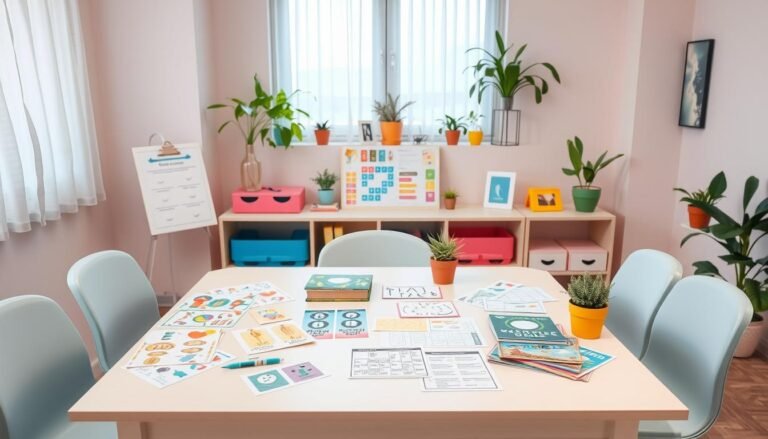
Disclosure: Some of the links in this post are affiliate links, which means that if you make a purchase through them, I may earn a small commission at no additional cost to you. I only recommend products that I believe will genuinely help you in your journey to earn money from home. These commissions allow me to keep creating helpful content and sharing practical advice, so thank you for supporting my blog!
Did you know that over 1,000 free ESL lesson plans are available on a specific website in PDF format? This wealth of resources highlights the growing demand for effective English as a Second Language (ESL) teaching tools. As an ESL teacher, I’ve discovered that well-crafted DEMO lesson plans are key to successful language instruction.
ESL DEMO lesson plans serve as blueprints for engaging and productive English classes. They help me organize my thoughts, structure my lessons, and ensure I cover all necessary components. These plans are particularly useful for last-minute situations or when adapting to students’ energy levels.
Effective lesson plan templates include clear objectives, low-prep activities, and adaptable content suitable for various teaching scenarios. By using these templates, I can focus on delivering quality instruction rather than scrambling to prepare materials.
The 120-hour Bridge Master Certificate provides valuable training in teaching methodologies and lesson-planning strategies for ESL teachers like me. It’s just one of many resources available to help create engaging and effective English lessons.
Key Takeaways
- ESL DEMO lesson plans are essential tools for effective English instruction
- Over 1,000 free ESL lesson plans are available online in PDF format
- Well-structured plans include clear objectives and adaptable activities
- Lesson plan templates save time and improve teaching quality
- Various resources, including certifications, offer training in lesson planning
What Are ESL DEMO Lesson Plans?
ESL DEMO lesson plans are essential ESL teaching resources that showcase a teacher’s skills and abilities. These plans outline lesson objectives, activities, and assessment strategies for potential employers or evaluators. As a language instructor, I’ve found these plans invaluable in preparing for interviews and demonstrating my teaching approach.
Definition and Importance of DEMO Lesson Plans
DEMO lesson plans are detailed outlines that serve as a roadmap for teaching English as a Second Language. They include key components such as lesson objectives, teaching materials, and assessment methods. These plans are crucial for several reasons:
- They demonstrate a teacher’s ability to organize and structure a lesson
- They showcase time management skills
- They highlight a teacher’s creativity in using language-learning materials
Objectives of an ESL DEMO Lesson
The main objectives of an ESL DEMO lesson are to:
- Engage students effectively
- Achieve specific learning outcomes
- Showcase various teaching techniques
- Demonstrate proficiency in using ESL teaching resources
In my experience, a well-prepared DEMO lesson plan can significantly increase your chances of landing a teaching position. It’s important to remember that different employers have varying expectations for these demonstrations. Also, having the right materials on hand, such as a portable whiteboard for quick visuals or flashcards for ESL, can transform a lesson and showcase versatility during demo sessions.
| Employer Type | Demo Lesson Requirement | Duration |
|---|---|---|
| International Schools | Often required | 30 minutes |
| Corporate Clients | Maybe part of rigorous selection | 15-30 minutes |
| Online Tutoring Companies | Usually required | 10-20 minutes |
| Private Tutoring | Sometimes requested | Varies |
Remember, a successful DEMO lesson showcases your ability to create engaging, effective language learning materials while managing time efficiently. It’s your opportunity to shine as an ESL instructor!
Components of Effective ESL DEMO Lesson Plans
Creating a solid ESL DEMO lesson plan is key to successful teaching. I’ve found that focusing on three main areas helps me craft lessons that really work for my students.
Lesson Objectives
Clear objectives guide my teaching. I always write them like this: “By the end of class, students will be able to…” This helps me stay on track and lets students know what to expect. For example, in a vocabulary lesson, my objective might be for students to use five new words in conversation.
Teaching Materials Needed
I make sure to list all materials I’ll use. This includes things for interactive activities, grammar exercises, and vocabulary builders. Here’s a quick look at what I often use:
| Material | Purpose | Example |
|---|---|---|
| Flashcards | Vocabulary practice | Picture cards for new words |
| Worksheets | Grammar exercises | Fill-in-the-blank sentences |
| Digital tools | Interactive activities | Kahoot! for vocabulary quizzes |

Assessment Strategies
I always include ways to check if students are learning. This might be a quick quiz, a speaking task, or a writing exercise. For instance, after a grammar lesson, I might have students write a short story using the new structure we learned.
By focusing on these three areas, I create lesson plans that keep my teaching organized and my students engaged. It’s a win-win for everyone in the classroom!
Popular ESL Teaching Methods for DEMO Lessons
ESL teaching methods play a crucial role in DEMO lessons. I’ll explore three effective approaches that showcase a teacher’s versatility and engage students actively.
Communicative Language Teaching (CLT)
CLT focuses on real-world communication skills. This method prioritizes fluency over accuracy, encouraging students to use English in practical situations. In DEMO lessons, I incorporate pronunciation drills within conversational exercises to enhance overall communication abilities.
Task-Based Learning (TBL)
TBL involves completing meaningful tasks using the target language. This approach fosters student independence and active English usage. During DEMO lessons, I present problem-solving activities that require collaborative efforts, allowing students to apply their language skills practically.
Total Physical Response (TPR)
TPR combines language with physical actions, making it highly effective for kinesthetic learners. This method is particularly useful for teaching vocabulary and following instructions. In my DEMO lessons, I use TPR to introduce new concepts, enhancing student engagement and retention.

| Method | Key Focus | DEMO Lesson Application |
|---|---|---|
| CLT | Real-world communication | Role-play scenarios, group discussions |
| TBL | Practical language use | Problem-solving activities, project work |
| TPR | Physical response to language | Action-based vocabulary games, Simon Says |
By employing these methods, I demonstrate my ability to adapt to different learning styles while maintaining effective classroom management tips. This versatility is key to delivering successful DEMO lessons and engaging students in the ESL learning process.
Steps to Create an ESL DEMO Lesson Plan
Creating effective ESL DEMO lesson plans is crucial for showcasing your teaching skills. I’ve found that a well-structured approach can make all the difference. Let’s dive into the key steps to craft a winning lesson plan template.
Research and Understand Your Audience
First, I always start by getting to know my students. Their proficiency level, interests, and learning goals shape my entire lesson. For instance, advanced learners might benefit from complex vocabulary and grammar, while beginners need simpler content.
Selecting a Topic or Theme
Choosing the right topic is vital. I aim for subjects that engage students and align with their needs. It’s important to avoid sensitive topics and focus on material that promotes active participation.
Outlining the Lesson Structure
A clear structure is the backbone of great lesson plan templates. I typically include these elements:
- Warm-up activity
- Introduction of new material
- Practice exercises
- Production tasks
- Assessment strategies
Remember, flexibility is key. Your ESL DEMO lesson plans should adapt to different classroom situations while maintaining focus on learning objectives.
| Lesson Component | Time Allocation | Activity Type |
|---|---|---|
| Warm-up | 5-10 minutes | Ice-breaker game |
| Introduction | 10-15 minutes | Presentation of new material |
| Practice | 15-20 minutes | Guided exercises |
| Production | 15-20 minutes | Group discussions or role-play |
| Assessment | 5-10 minutes | Quick quiz or peer evaluation |
By following these steps, you’ll create engaging and effective ESL DEMO lesson plans that impress observers and benefit your students.
Examples of ESL DEMO Lesson Plan Templates
I’ve found that having a solid template is crucial when crafting ESL DEMO lesson plans. Let’s explore some examples for different proficiency levels, showcasing how to use esl teaching resources effectively.
Beginner Level Example
For beginners, I focus on basic vocabulary and simple structures. A typical lesson might look like this:
- Warm-up: Picture matching game (5 minutes)
- Introduction: Present new food vocabulary (10 minutes)
- Practice: Gap-fill exercise with food words (15 minutes)
- Produce: Role-play ordering food in a restaurant (20 minutes)
Intermediate Level Example
At this level, I incorporate more complex grammar and interactive activities:
- Warm-up: List Race with adjectives (5 minutes)
- Introduction: Present comparative adjectives (10 minutes)
- Practice: Tic-Tac-Verb game with comparatives (15 minutes)
- Produce: Group discussion comparing cities (20 minutes)
Advanced Level Example
For advanced learners, I use authentic language learning materials and challenging tasks:
- Warm-up: Sentence Scramble with idiomatic expressions (5 minutes)
- Introduction: Analyze a news article (15 minutes)
- Practice: Debate on the article’s topic (20 minutes)
- Produce: Write a response essay (10 minutes)
| Level | Key Focus | Sample Activity |
|---|---|---|
| Beginner | Basic vocabulary | Picture matching |
| Intermediate | Complex grammar | Tic-Tac-Verb |
| Advanced | Authentic materials | News article analysis |
Remember, these templates are flexible. Adapt them based on your students’ needs and interests to create engaging ESL lessons.
Tips for Delivering a Successful ESL DEMO Lesson
Delivering a great ESL demo lesson can be nerve-wracking, but with the right approach, you’ll shine. I’ve gathered some top tips to help you engage students and manage your time like a pro.
Engaging Your Students
Student engagement is key to a successful demo. I always start by choosing interactive activities that suit my audience. For instance, if I’m teaching adults, I might use role-plays focused on workplace scenarios. For younger learners, games work wonders.

- Use visual aids to cater to different learning styles
- Incorporate group discussions to encourage participation
- Implement technology-based activities when appropriate
- Provide constructive feedback to boost confidence
Managing Time Effectively
Time management is crucial in demo lessons. I always prepare a clear timeline for each activity and practice beforehand. This helps me stay on track and adjust as needed during the actual demo.
Some effective classroom management tips include:
- Set clear expectations at the start of the lesson
- Use a visible timer to keep activities on schedule
- Have a backup plan for activities that might run short or long
- Leave time for questions and wrap-up at the end
Remember, a successful demo showcases your ability to create a positive learning environment. By focusing on engagement and time management, you’ll impress both students and observers alike.
Common Challenges in ESL DEMO Lessons
As an ESL teacher, I’ve encountered various hurdles during demo lessons. These challenges can make or break your chance of landing that dream teaching position. Let’s dive into some common issues and how to tackle them with effective classroom management tips and esl teaching resources.
Student Resistance or Lack of Engagement
One of the biggest obstacles I face is when students seem uninterested or resistant to participate. To combat this, I use a variety of engaging activities tailored to students’ interests. For example, incorporating games or interactive technology can spark enthusiasm and encourage active learning.
Time Management Issues
Another frequent challenge is managing time effectively during a demo lesson. Unexpected student responses or technical difficulties can throw off your carefully planned schedule. I’ve learned to prepare backup activities and practice my lesson timing beforehand to stay flexible and adaptable.
| Challenge | Solution |
|---|---|
| Student Resistance | Use varied, interesting activities |
| Lack of Engagement | Tailor content to students’ interests |
| Time Management | Prepare backup activities |
| Technical Issues | Practice with equipment beforehand |
By addressing these challenges head-on and utilizing effective classroom management tips, you’ll demonstrate your adaptability as a teacher. Remember, being prepared with a variety of ESL teaching resources can help you navigate any unexpected situations that arise during your demo lesson.
Resources for ESL Teachers
ESLAs an ESL teacher, I’ve found a wealth of ESL teaching resources and language learning materials that have greatly enhanced my lessons. These tools have been lifesavers, especially when I had to plan fifteen weeks of classes in South Korea with little notice.
Recommended Websites for Lesson Planning
Pinterest is a goldmine for ESL activities, particularly for summer camps. I often use websites with pre-graded lesson plans for adults, kids, and teens. Busy Teacher is my go-to for worksheets and board games. For computer-based learning, I rely on interactive game sites, which work well in smaller classes.
Books and Materials for ESL Instruction
While online resources are great, I still value traditional books for ESL instruction. Here’s a table of some popular ESL teaching materials:
| Resource Type | Examples | Best For |
|---|---|---|
| Websites | Busy Teacher, Pinterest | Quick activities, worksheets |
| Apps | Gamification apps | Engaging language practice |
| Video Platforms | YouTube | Visual learning, listening practice |
| Membership Sites | Full syllabus downloads | Comprehensive lesson planning |
These resources offer themed lessons, age-specific content, and materials like flashcards and PowerPoint presentations. Remember, the key is to mix and match these esl teaching resources to create engaging and effective lessons for your students.
Final Thoughts on ESL DEMO Lesson Plans
As I reflect on my journey with ESL DEMO lesson plans, I’m amazed at how they’ve shaped my teaching career. Last year alone, I crafted 492 lessons, dedicating 15 hours weekly to classroom instruction. These experiences have been invaluable in honing my skills as an English as a second language educator.
The Importance of Continuous Improvement
I’ve learned that the key to successful ESL DEMO lesson plans lies in ongoing refinement. By consistently evaluating and adapting my approach, I’ve seen a notable increase in student engagement and positive feedback. For instance, I now spend just 30 minutes prepping before each class, a significant improvement from my early days of teaching.
Encouragement for New ESL Teachers
To new ESL teachers, I say embrace the challenge of creating effective DEMO lesson plans. Remember, it’s a skill that develops over time. I’ve found great success using resources like Oxford University Press’s English File series. Don’t be afraid to use online materials to fill unexpected gaps in your lessons. With practice, you’ll find your unique teaching style and create engaging ESL DEMO lesson plans that resonate with your students.






